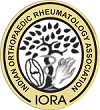- Visibility 30 Views
- Downloads 6 Downloads
- DOI 10.18231/j.ijor.2023.004
-
CrossMark
- Citation
Prevalence of primary osteoarthritis of knee in tea garden community of Jorhat District, Assam
Introduction
The most prevalent form of degenerative joint disease, osteoarthritis (OA), is one of the major causes of pain and disability, particularly in middle-aged and older people. Almost 250 million people throughout the world are affected by this degenerative joint condition.[1] The cartilage and many of the tissues around it are affected by OA. In addition to the destruction and loss of articular cartilage, there is also ligamentous laxity, multiple osteophytes development, periarticular muscle weakness, and, in certain cases, synovial inflammation. Due to an imbalance between the restrictions on mobility, these modifications take place. The advancement of the disease is often relatively slow, but it can eventually result in joint failure, which is painful and incapacitating.[2] Knees, hips, hands, spine, and feet are the most common joints affected by osteoarthritis (OA).[3] The knee joint is the part of the lower limb that is most frequently afflicted. Knee OA is more common in women than in men over 65 years old (68% versus 58%, respectively).Joint pain and stiffness are among the primary symptoms of OA, which is second in the list of reported chronic health issues after allergies. As people get older, knee OA becomes more common and more severe.[4]
OA is the biggest cause of disability in the US, affecting more than 21 million people.[5], [6] In the Asia-Pacific region, the prevalence of Knee Osteoarthritis was 7.5% in Bangladesh, 5.78 in rural India, 22.0% - 28.0% in urban areas, and 25.0% in North Pakistan's rural population.[7] Agra (35.5%), Bangalore (26.6%), Kolkata (33.7%), Dehradun (27.2%), and Pune (21.7%) showed slightly different prevalence rates of OA than the national average of 28.7% discovered through studies conducted throughout India.[8] Even though the OPD attendance in hospitals related to OA knee is quite high from tea gardens of Assam, a review of the available literature showed few reports about the prevalence and determinants of OA in tea gardens of Assam. Hence the current study aimed to find out the prevalence and the determinants of OA in tea garden community of Jorhat district of Assam.
Aim and Objective
To assess the prevalence of primary osteoarthritis of the knee in the tea garden community of Jorhat district of Assam based on the following parameters:
Medical History
Clinical Examination (WOMAC score).
Weight-bearing (standing) Anterior-posterior X-rays of both the knees
Materials and Methods
A community-based Cross-Sectional study was conducted over a period one year in the Department of Orthopaedics of Jorhat Medical College & Hospital, Jorhat, Assam and some tea gardens within the Jorhat District from June 2019 to May 2020.Permission was obtained from the Institutional Ethics Committee (H), Jorhat Medical College & Hospital, Jorhat prior to the commencement of the study. The study was conducted in population of more than 40 years of age in 5 randomized tea gardens in Jorhat district of Assam, who meets the inclusion criteria for the study. Sample size was calculated and estimated as 320 using the formula n= (1.96) ² *p*q/d where P-30% Q-100-P-70% d-allowable error-05%. Therefore n= (1.96 × 1.96 × 0.3×0.7) /(0.05 0.05)=322 Thus a sample size is taken to be 320 no. of patients. There are 8 blocks in Jorhat district out of which 2 blocks namely TITABAR BLOCK and BAGHCHUNG BLOCK were randomly selected. From these blocks, 5 random tea estates were taken and 64 random estates. number of samples were collected. Data collection was done by Home-to-home visits, Health camps organised in target tea gardens, Visits to tea garden hospitals, Orthopaedics OPD. JMCH. Residents of tea gardens of Jorhat district, Men and women above 40 years, Patient's ability to understand and help complete the proforma Patient's agreement to participate in the study were included in our study. Prevalence of osteoarthritis of knee in tea garden community of Jorhat district of Assam based on the following parameters - Medical history Clinical examination (WOMACSCORE) and X-ray: Antero-posterior (weight[U1] [BG2] [U3] [BG4] bearing) radiographs of both the knees using Kellgren and Lawrence method of grading. Statistical Program for Social Sciences (SPSS for Windows, version 20.0, Chicago, SPSS Inc.) and Microsoft Excel 2010 were used to perform the statistical analysis of the data. Association between sociodemographic variables and risk of osteoarthritis, and association between lifestyle factors and risk of osteoarthritis were calculated using odds ratio (95% confidence interval) and p value. Multivariable logistic regression model was used for calculating the determinants of osteoarthritis knee. For all analyses, the statistical significance was fixed at 5% level (p value<0.05).
Results
The overall prevalence of osteoarthritis in the study population was found to be 29.4% i.e., 94 out of 320 patients.
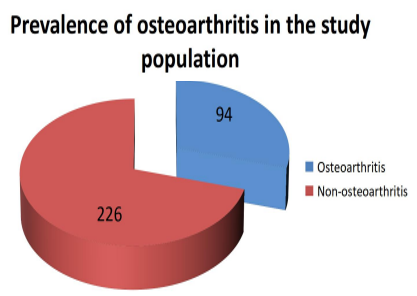
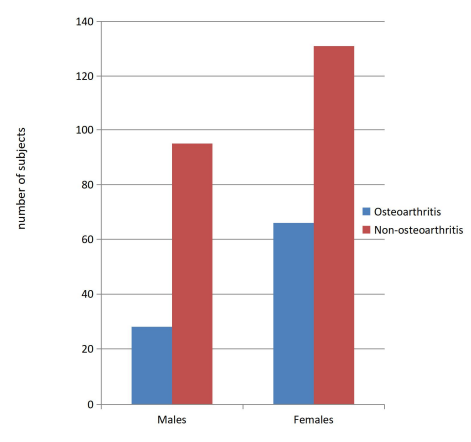
Out of 131 males 28(29.8%) had osteoarthritis. On the other hand, out of 197 females66(70.2%) had osteoarthritis. OR (95% CI) was 1.71 (1.02-2.86) and p-value was 0.041.
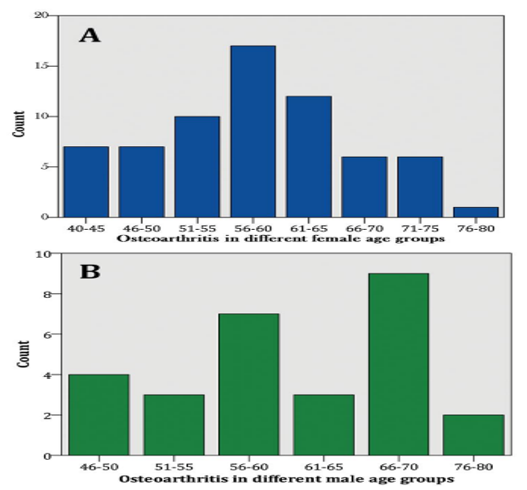
The above figure, shows the prevalence of osteoarthritis in different age group.
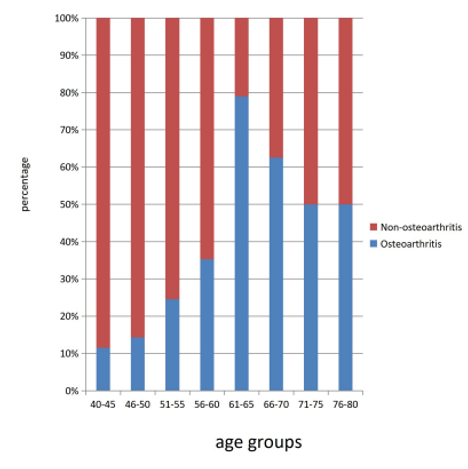
Out of 135 patients whose age were less than or equal to 50 years only 18(19.1) had osteoarthritis. On the other hand out of 185 patients who aged more than 50 years 76(80.9) had osteoarthritis
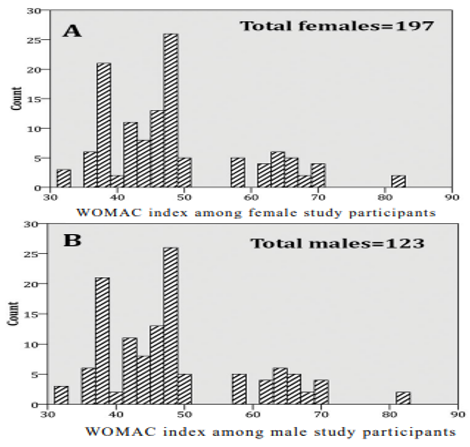
The above figure shows the WOMAC index distribution among male and female participants.
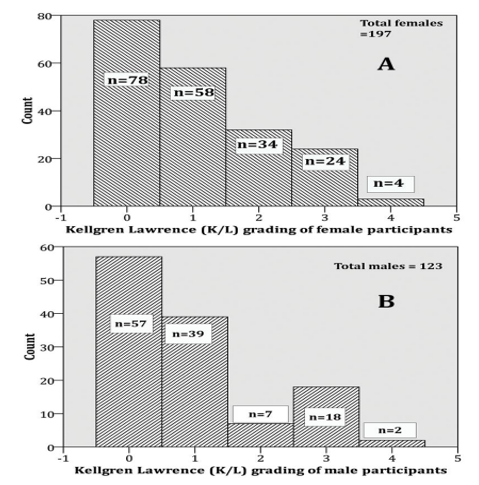
The above figure shows the Kellgren and Lawrence grading of male and female participants.
Discussion
The knee, which is made up of the distal femur, proximal tibia, and patella, as well as meniscus and hyaline cartilage, ligaments, and a synovial membrane, is the biggest synovial joint in humans. The avascular cartilage receives lubrication and nourishment from the synovial fluid, which is produced by the synovium. Due to the knee joint's unfortunate high use and stress, it is frequently the location of uncomfortable conditions like OA[1] OA is a degenerative joint condition that affects the cartilage and many of the tissues around. In addition to the destruction and loss of articular cartilage, other features include the remodelling of subchondral bone, the production of many osteophytes, ligamentous laxity, periarticular muscle weakness, and, in certain cases, synovial inflammation. [2]
F. V. Wilder et al [5] conducted a study in 2002 where they quoted OA to affect more than 21 million Americans and is the leading cause of disability in the United States.
Michelle J Lespasioet al [6] in their study conducted in the year 2017 commented that Knee OA affects adults mostly of age 65 or more, with a prevalence being 33.6 % (12 .4 million) in the United States.
J. Viswanathet al [9] did a study in S. V. Ayurvedic Medical College and Hospital and found that the prevalence of osteoarthritis in patients in South Indian hospital and was reported to be in the range of 17 to 60.6% in India.
MuruganNatesanet al. [10] in their study to found out that the Prevalence of Osteoarthritis of Knee Joint among Adults in a Rural Area of Kanchipuram District, Tamil Nadu was 27.1 %.
Harish Kumar et al.[8] found prevalence of OA to be 28.7% in the entire sample when researchers looked at the "Epidemiology of knee osteoarthritis using Kellgren and Lawrence scale in Indian population" The prevalence was a little bit different in the different states: Agra (35.5%), Bangalore (26.6%), Kolkata (33.7%), Dehradun (27.2%), and Pune (21.7%).
In our present community-based study, the prevalence of osteoarthritis of knee was 29.4 % (94 /320) which is similar to some other studies cited above.
Adam G Culvenor et al[11] in their "systematic review and meta- analysis on Prevalence of knee osteoarthritis features on magnetic resonance imaging in asymptomatic uninjured adults" estimated that among otherwise healthy asymptomatic uninjured knees, the prevalence of MRI features suggestive of OA ranged from 4% to 14% in young adults to 19% to 43% in older adults aged 40 years.
Yong Ping Li et al[12] in their article “The Age-Related Changes in Cartilage and Osteoarthritis” Stated that As the population ages, the financial and social constraints brought on by OA have gotten much worse. Age-related cartilage alterations have been identified as key contributors to the development of OA.
Michelle J Lespasio et al. [6] in their article Knee Osteoarthritis: A Primer stated that 33.6% of persons in the US aged 65 or older have knee OA, making it the most common form of the disease (12.4 million). Men have a lower prevalence (31.2%) than women (42.1%).
In our study we found that the prevalence of OA knee was higher in females -33.5% (66/197) than in males--22 .8% (28/123); females being at a significantly higher risk of osteoarthritis (1.71, 95% CI 1.02 -2.86). In addition, women in their 50s and beyond were aa greater risk of suffering from osteoarthritis (4. 53, 95% CI 2.54 -8.06). OA was frequent among women in the 56-60 age group, but most cases were recorded in the 66-70 years age group among males. This might be due to the fact that our study sample consisted of more females than males or women are at higher risk of developing osteoarthritis of the knee as suggested by most of the literature. In our study the prevalence of primary osteoarthritis of knee was 29.4% (94/320). The prevalence of OA knee was higher in females -33.5% (66/197) than in males - 22.8% (28/123). Females were at a significantly higher risk of osteoarthritis (1.71, 95% CI 1.02-2.86). Women in their 50s and beyond were at a greater risk of suffering from osteoarthritis (4.53, 95% CI 2.54-8.06). OA was frequent among women in the 56-60 age group, but most cases were recorded in the 66-70 years age group among
Conclusion
This study was conducted to find out the prevalence of primary osteoarthritis of the knee in the tea garden community of the Jorhat district of Assam based on medical history, WOMAC score and Weight-bearing (standing) anteroposterior X-ray views of both the knees. The present study to our best knowledge is the only study done in tea gardens of Jorhat district of Assam. The prevalence of osteoarthritis of the knee was 29.4%. The prevalence of OA knee was higher in females (33.5%) than in males (22.8%). This difference is similar to findings of other studies discussed before and is also probably contributed to by factors such as prolonged standing, squatting, weight lifting and walking on uneven and sloping terrain. It is also due to the fact that women are more involved in works in the tea gardens than men as such they are more susceptible to mechanical load on their knees. The disability caused by osteoarthritis has increased the incidence of joint replacement surgeries which are expensive and technically demanding procedures. Prevention of the onset and progression of the disease can contribute greatly to the reduction of the need for replacement surgeries and reduce the economic burden on patients and the state. Having determined the prevalence of OA and the risk factors, and their association with OA it will be helpful for these people if the concerned authorities organize health camps screening camps and health education programs with an objective to lower the incidence of OA or to slow down the disease progression in the prevalent OA cases. We hope these data will promote a sense of awareness regarding osteoarthritis among health care providers. This data can be used to identify subjects who require further follow up and evaluation. However, a truly representative sample from all tea gardens of Jorhat district with a larger sample size is needed to further establish and justify the findings of this study.
Conflict of Interest
None.
Source of Funding
None.
References
- JC Mora, R Przkora, Y Cruz-Almeida. Knee osteoarthritis, Pathophysiology and current treatmentmodalities. J Pain Res 2018. [Google Scholar] [Crossref]
- A Litwie, S Registrar, M Edwards, M Clinical. Epidemiology and burden of osteoarthritis. Br Med Bull 2013. [Google Scholar] [Crossref]
- C Palazzo, C Nguyen, M M Lefevre-Colau, F Rannou, S Poiraudeau. Risk factors and burden of osteoarthritis. Ann Phys Rehabil Med 2016. [Google Scholar]
- GLY Cheing, CWY Hui-Chan. The motor dysfunction of patients with knee osteoarthritis in a Chinese population. Arthritis Care Res 2001. [Google Scholar]
- FV Wilder, BJ Hall, JP Barrett, NB Lemrow. History of acute knee injury and osteoarthritis of the knee: a prospective epidemiological assessment. The Clearwater Osteoarthritis Study. Osteoarthritis Cartilage 2002. [Google Scholar] [Crossref]
- MJ Lespasio, NS Piuzzi, ME Husni, GF Muschler, A Guarino, MA Mont. Knee Osteoarthritis: A Primer. Perm J 2017. [Google Scholar] [Crossref]
- G Peat, R Mccarney, P Croft. Knee pain and osteoarthritis in older adults: a review of community burden and current use of primary health care. Ann Rheum Dis 2001. [Google Scholar] [Crossref]
- H Kumar, CP Pal, YK Sharma, S Kumar, A Uppal. Epidemiology of knee osteoarthritis using Kellgren and Lawrence scale in Indian population. J Clin Orthop Trauma [Internet] 2020. [Google Scholar] [Crossref]
- J Viswanath, C Cheekavolu, R Dixit, S Sankaraiah. Prevalence of osteoarthritis patients in South Indian hospital. Int J Community Med Public Heal 2017. [Google Scholar] [Crossref]
- J Venkatachalam, M Natesan, M Eswaran, AKS Johnson, V Bharath, Z Singh. Prevalence of osteoarthritis of knee joint among adult population in a rural area of Kanchipuram District, Tamil Nadu. Indian J Public Health 2018. [Google Scholar]
- AG Culvenor, BE Øiestad, HF Hart, JJ Stefanik, A Guermazi, KM Crossley. Prevalence of knee osteoarthritis features on magnetic resonance imaging in asymptomatic uninjured adults: a systematic review and meta-analysis. Br J Sports Med 2019. [Google Scholar] [Crossref]
- Y Li, X Wei, J Zhou, L Wei. The age-related changes in cartilage and osteoarthritis. Biomed Res Int 2013. [Google Scholar] [Crossref]
